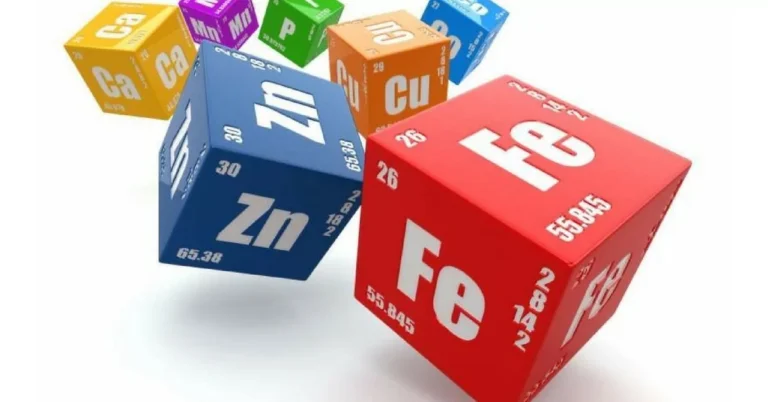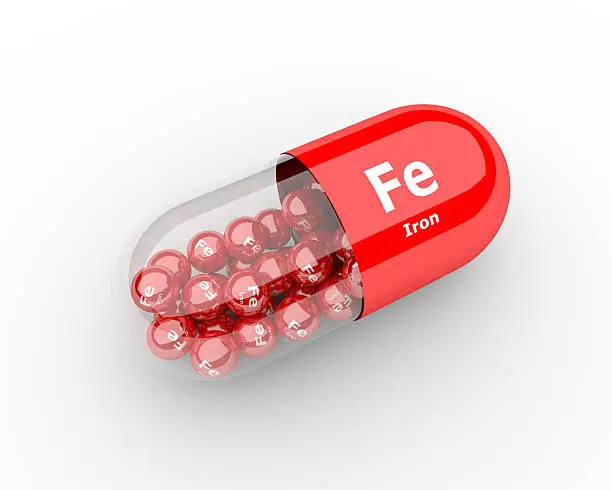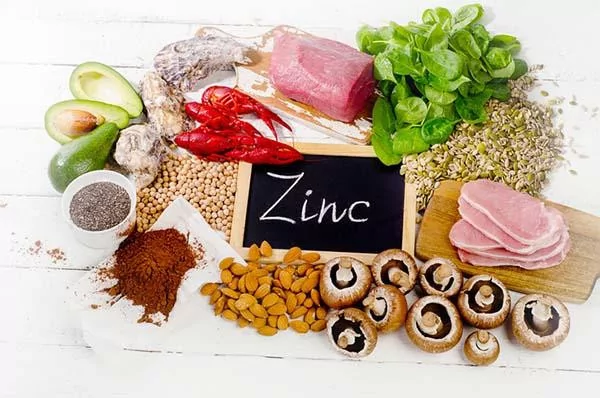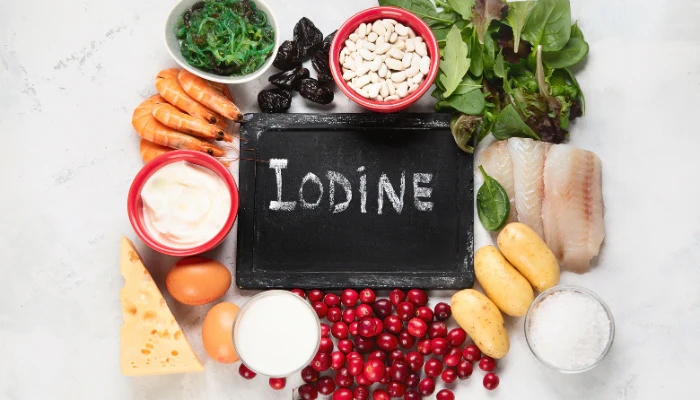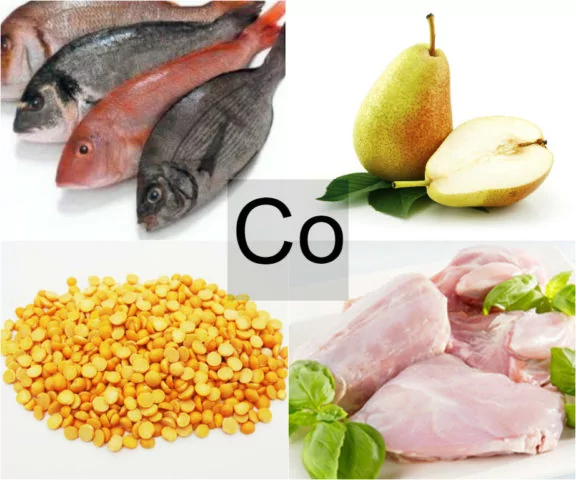Essential trace elements range from metals to non-metals. What makes them essential is their variable oxidation state. They are important parts of oxidative-reduction enzymes in the body. They also have roles in transport proteins, cofactors, and detoxification and defense. Trace elements are carried bound to transport proteins in the blood. Because they are generally toxic when in free form, they are transported bound from entry to exit within the body.
Iron
Iron is important in the transportation of oxygen from the lungs by way of the blood stream to the tissues. It is present in the red blood cell protein, hemoglobin. A similar protein in muscle, myoglobin, also contains iron and stores oxygen for use during muscle contraction. Iron is found in the portion of the cell involved in energy production and as a cofactor for several enzymes.
Deficiency
Iron deficiency generally occurs during the growth period or when intake fails to replace iron loss that is associated with blood loss. When iron stores are depleted and there is inadequate production of heme (the portion of hemoglobin associated with the iron), the red blood cells become small (microcytic) and have decreased capacity to carry oxygen. There is also a drop in iron-containing enzymes that are important in cellular metabolism. This results in decreased work capacity, fatigue and altered behavior such as irritability.
Toxicity
Iron poisoning is the most common cause of death resulting from poisoning in children. Supplemental iron can cause gastric irritation, abdominal pain, constipation, diarrhea, nausea and vomiting. Certain antacids may decrease the absorption of iron supplements.
The RDA for iron in males over 19 years is 10 mg; for females of 11-50 years, 15 mg; for females over 51 years, 10 mg; for pregnant females, 30 mg; and for lactating females, 15 mg. Not all forms of iron are the same: 1 gram of ferrous gluconate = 120 mg elemental iron; 1 gram ferrous sulfate = 200 mg elemental iron; and 1 gram of ferrous fumarate = 330 mg elemental iron.
Zinc
Zinc is important in growth, appetite, development of the testicles, skin integrity, mental activity, wound healing, and proper functioning of the immune system. Zinc is a cofactor for many enzymes, which means that zinc is necessary for the proper functioning of these enzymes. These enzymes participate in the metabolism of carbohydrates, lipids, proteins and nucleic acids (such as DNA). Zinc is involved in the functioning of the immune system and in the expression of genetic information. Zinc is present in bone and is involved in the regulation of bone calcification. It is also present in members of a class of proteins called the metallothioneins that are believed to provide antioxidant protection by scavenging free radicals.
Recently zinc lozenges have been used to reduce the duration or severity of the common cold and other upper respiratory tract infections of viral origin. Investigations are underway to verify these claims. Zinc lozenges can cause mouth irritation, nausea and diarrhea. The lozenges should not be used more than one week. The unpleasant taste of the lozenges is a frequent complaint. When applied topically, zinc acts as an astringent and a weak antiseptic. Zinc oxide is used topically as a sunblock and to treat skin conditions such as chafing, diaper rash, and minor skin irritations.
The RDA of zinc for males 11 years and older is 15 mg; for females 11 years and older, 12 mg; for pregnant females, 15 mg; for lactating females during the first 6 months, 19 mg; and during the second 6 months, 16 mg.
Deficiency
A zinc deficiency may be associated with diets high in unrefined cereal and unleavened bread, long term IV nutrition, or diseases of the intestine such Crohn’s disease, alcoholism, or pregnancy.
Toxicity
Toxicity from zinc supplements can cause flu-like symptoms, fever, epigastric pain, fatigue, vomiting, dehydration, anemia, depressed immune function and decrease in the “good” form of cholesterol. Excessive zinc interferes with the function of copper and iron.
Iodine
Iodine is absorbed well, circulates both free and bound, and is sequestered in the thyroid gland where it is incorporated into the thyroid hormones, triiodothyronine (T3) and thyroxine (T4). These hormones are important in regulating the basal metabolic rate (associated with energy production) of adults, and the growth and development of children. Iodine is sometimes used to help thin secretions from the lung in order to help expel the secretions. It is used on the skin as an antiseptic, although it may stain the skin, irritate tissues and cause sensitization in some people.
Deficiency
Deficiency is manifest by a decreased metabolic rate, lethargy and obesity. A prolonged deficiency of iodine causes the thyroid gland to increase in size such that a large nodule referred to as a goiter, protrudes from the neck. In many countries inorganic iodides are added to table salt to prevent the deficiency. Iodine deficiency in infants and children results in mental retardation. Inadequate maternal intake causes a deficiency in the fetus and newborn. Early recognition of the syndrome is key to minimizing mental retardation. Some plants produce goitrogens (cabbage, plantain). These substances fool the thyroid and inhibit the synthesis of the thyroid hormones. Arsenic can also inhibit the synthesis of thyroid hormones by interfering with normal thyroid function.
Toxicity
High doses of iodides (the salts of iodine) inhibit thyroid hormone synthesis and release. As lack of iodine leads to symptoms of thyroid deficiency, so do excessive doses of iodides. It is sometimes used to treat hyperthyroidism. With prolonged excessive intake, a goiter can occur. Sometimes a large dose of iodides is given before thyroid surgery to shrink the size of the thyroid gland.
Some people are hypersensitive to iodine and this can lead to skin rashes, mucous membrane ulcers, a fever, “iodism” (metallic taste, gastric irritation, burning mouth and throat, sore teeth and gums, symptoms of a head cold), and swelling in the neck area. Iodine supplements can cause acne. Health food formulations containing kelp can also cause acne due to the high content of iodine.
The RDA for iodide in males and females over 12 years is 150 mg; for pregnant females, 175 mg; and for lactating females, 200 mg. The content of iodide in iodized table salt is 76 mg/g of salt; therefore with an average use of 3.4 g per day, approximately 200 mg of iodide is consumed.
Chromium
Chromium is an essential trace element that is needed for carbohydrate, fat, and nucleic acid (DNA or RNA) metabolism. Main sources in the diet include whole grains, egg yolks, brewer’s yeast, liver, meats, and nuts. Signs of a chromium deficiency are usually only seen in adults eating highly refined foods or in people who are receiving long-term IV nutrition that lack chromium. With a chromium deficiency, blood sugar levels are generally high. There may also be abnormalities of nerve stimulation of the extremities (arms, hands, legs and feet) and alterations of brain tissue.
There are some people with type 2 (non-insulin dependent) diabetes that appear to have improved blood sugar control with chromium supplementation, but this is not seen in all diabetics. Chromium is part of the glucose tolerance factor (GTF) that is required for insulin action, however more thorough studies need to be conducted before supplementation in diabetics becomes a general recommendation. There is no scientific basis for the use of chromium supplements by athletes to increase muscle mass or to reduce body fat. Chromium supplements may lower cholesterol and triglycerides in people with diabetes as well as with nondiabetics, but it may take months before this result is seen and the effect may not be substantial. Chromium appears to affect some of the enzymes that regulate cholesterol synthesis. The mechanism by which chromium participates in proper nerve function is not well understood.
Chromium picolinate is the most well absorbed form of chromium currently available. The RDA is 50 to 200 micrograms. Not many side effects have been reported from the use of chromium supplements unless excessive doses are taken. This has resulted in liver and kidney failure, anemia, muscle breakdown and abnormalities in blood clotting. People with impaired kidney function should seek medical advice before taking supplements.
Cobalt
Cobalt has a central action in vitamin B12 function. Meats provide cobalt as a component of vitamin B12. If the vitamin B12 requirement is met, then the cobalt requirement is met. It is not known if cobalt has other functions. An RDA has not been established. Cobalt can be toxic to humans because it is not regulated at the point of absorption. Excess cobalt can cause polycythemia (increased red blood cells), bone marrow hyperplasia, pancreatic failure or congestive heart failure. At large doses it also interferes with the absorption of iron.
Copper
Copper is incorporated into many enzymes and is necessary for their actions. For example, the copper containing ceruloplasmin is involved in the transport of iron in the blood to places where hemoglobin synthesis occurs. Another enzyme is involved in maintaining connective tissue integrity, and in copper deficiency, defective bone matrix and osteoporosis may occur.
Deficiency
Although a deficiency is rare, it can occur in people with prolonged diarrhea or other disorders of intestinal absorption. It can also occur in the presence of high dose zinc supplementation. Signs of a deficiency include anemia, a decrease in certain white blood cells, skeletal demineralization, loss of hair color, and skin pallor. Children with copper deficiencies may experience ruptured blood vessels, central nervous system abnormalities, growth retardation, and poor temperature regulation.
Toxicity
Excessive doses of copper can cause diarrhea, epigastric pain and discomfort, blood in the urine, liver damage, low blood pressure and vomiting. No RDA has been established for copper.
Two diseases are associated with abnormal copper metabolism: Wilson’s disease is marked by high levels of copper, especially in the brain, liver, kidney and eye; Menke’s kinky hair syndrome results from defective transport of copper into the blood of male infants and is associated with retarded growth and a kinky appearance of the hair.
Manganese
Manganese assists in the activity of many enzymes, including some involved in lipid, protein, and carbohydrate metabolism.
Deficiency
Manganese deficiency has not been well documented in humans. A few people on manganese deficient diets showed signs of elevated calcium and phosphorus, suggesting that dissolution of bone to release manganese stores may also release calcium and phosphorus into the blood. As such, it is speculated that a manganese deficiency may be a contributing factor for osteoporosis. In animals, a deficiency has been associated with abnormal reproductive ability, growth retardation, birth defects, abnormal formation of bone and cartilage, dermatitis, and impaired glucose handling.
Toxicity
Chronic poisoning from manganese inhalation by miners has caused dementia, psychiatric disorders similar to schizophrenia, and neurological changes resembling Parkinson’s disease. Iron and manganese affect the absorption of each other. Chronic liver disease can cause manganese accumulation and toxicity. No RDA has been established for manganese.
Molybdenum
Molybdenum is part of the molecular structure of several enzymes. One of these enzymes is involved in the formation of sulfate. Under normal circumstances, there have been no reports of molybdenum deficiency. In patients maintained solely on IV nutrition that lack molybdenum for prolonged periods, headache, irritability, lethargy and coma have occurred but have been rapidly reversed upon addition of molybdenum. An excess of molybdenum interferes with copper and iron absorption. No RDA has been established for this element.
Selenium
Selenium is an essential nonmetallic element. Foods containing selenium include meat, poultry, grains, and seafood. Some reports have suggested that selenium may protect against certain types of cancer, but large trials in humans are needed to support this. Selenium is important for the function of several proteins. One of these is glutathione peroxidase, an enzyme that prevents oxidative damage to cells from a variety of peroxides. Selenium also appears to bind to some minerals such as arsenic and mercury and decrease their toxicity.
Deficiency
Although selenium deficiency is uncommon in the United States, low levels in the body may be associated with acute illness and prolonged IV nutrition. Symptoms of selenium deficiency include muscle weakness and pain, inflammation of the muscles, fragile red blood cells, degeneration of the pancreas, and abnormal coloration. There have also been associations of selenium deficiency with several diseases affecting the heart muscle, but a protective effect against heart disease has not been proven. In geographic areas where selenium is deficient in the soil and therefore in food, human deficiencies have been reported to cause dilation of the heart and congestive heart failure.
Toxicity
Side effects with high doses of selenium supplements include hair and nail loss, skin lesions, fatigue, irritability, liver and kidney damage, nausea, vomiting and abnormal blood clotting. Animals in the west grazing on plants that have accumulated selenium show acute or chronis selenium poisoning. Chronic selenium toxicity (alkaline disease) is characterised by muscle degeneration, rough coat, labored breathing and cardiovascular failure. Acute selenium toxicity (blind staggers) manifests as weight loss, anorexia, excessive salivation, jaundice or necrosis of the heart and liver.
For cancer prevention, a typical dose of selenium is 200 micrograms per day. The RDA for women over 19 years is 55 micrograms; for pregnant women, 65 micrograms; for lactating women, 75 micrograms; and for men over 19 years, 70 micrograms.
Fluoride
Fluoride may not actually function as an essential trace element but it has beneficial effects on skeletal and dental health. Fluoride assists in the prevention of tooth decay. It works by increasing the tooth resistance to acid, promoting remineralization, and inhibiting the process by which bacteria promote cavities. There is also evidence that fluoride helps protect against osteoporosis. It is associated with a decrease in bone demineralization. Fluoridation of the water supply is an effective method for providing fluoride. Oral supplements are available for people that do not have access to fluoridated water. Although there is no RDA for fluoride, the protective effect of fluoride for teeth occurs at an intake of 1.5 mg/day or more for adults. Intakes over 2.5 mg/day in children may cause mottling of the teeth.
Toxicity
Acute toxicity has occurred by ingestion of household products containing high levels of fluoride such as certain insecticides. The mechanism of fluoride toxicity is conversion in the stomach to hydrofluoric acid. Gastrointestinal symptoms predominate and include nausea, vomiting, diarrhea, and abdominal pain. Chronic ingestion of high amounts of fluoride during tooth development results in dental fluorosis and mottling of teeth. It can also result in increased density and calcification of bone, and in severe cases is referred to as crippling skeletal fluorosis.


